Apple's Weather app has been around forever, at least for iPhone, and it's gone through many design changes over the years. But we're at a point now where we can actually customize how the Weather app looks and feels in many different ways, some of which you probably haven't even considered.
1. Add All the Cities
I'm sure everyone knows this already, but I have to mention it — you can add cities to Weather. The default view is for "My Location," but you can add up to 19 cities on iOS 15 to view in a list or swipe through. That number goes up to 49 cities on iOS 16. To add a city, tap the list button in the bottom right, then use the search bar to find the city you want. Select the city from the results, then tap "Add."
In the list view, you'll find brief details about all of your cities, and you can choose one to expand if you want to learn more. When in an expanded view, you can swipe left or right to move between the locations. You can also use the scroll bar at the bottom to move more quickly through your cities.
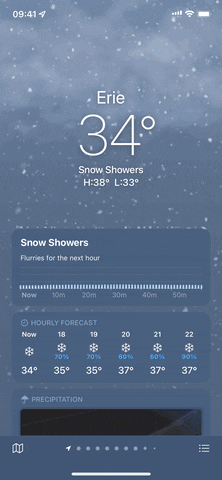
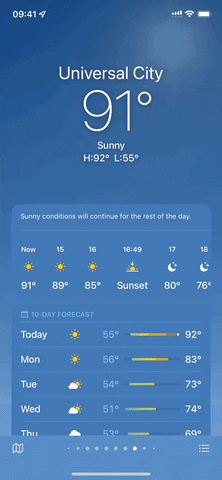


If you ever want to delete a city, you can long-swipe left on it from the list view and watch it disappear. You can also short-swipe left and hit the trash can icon. For yet another way, tap the ellipsis (•••) icon, choose "Edit List," hit the minus sign next to the city, use the trash button to confirm, and hit "Done" to return to the list.
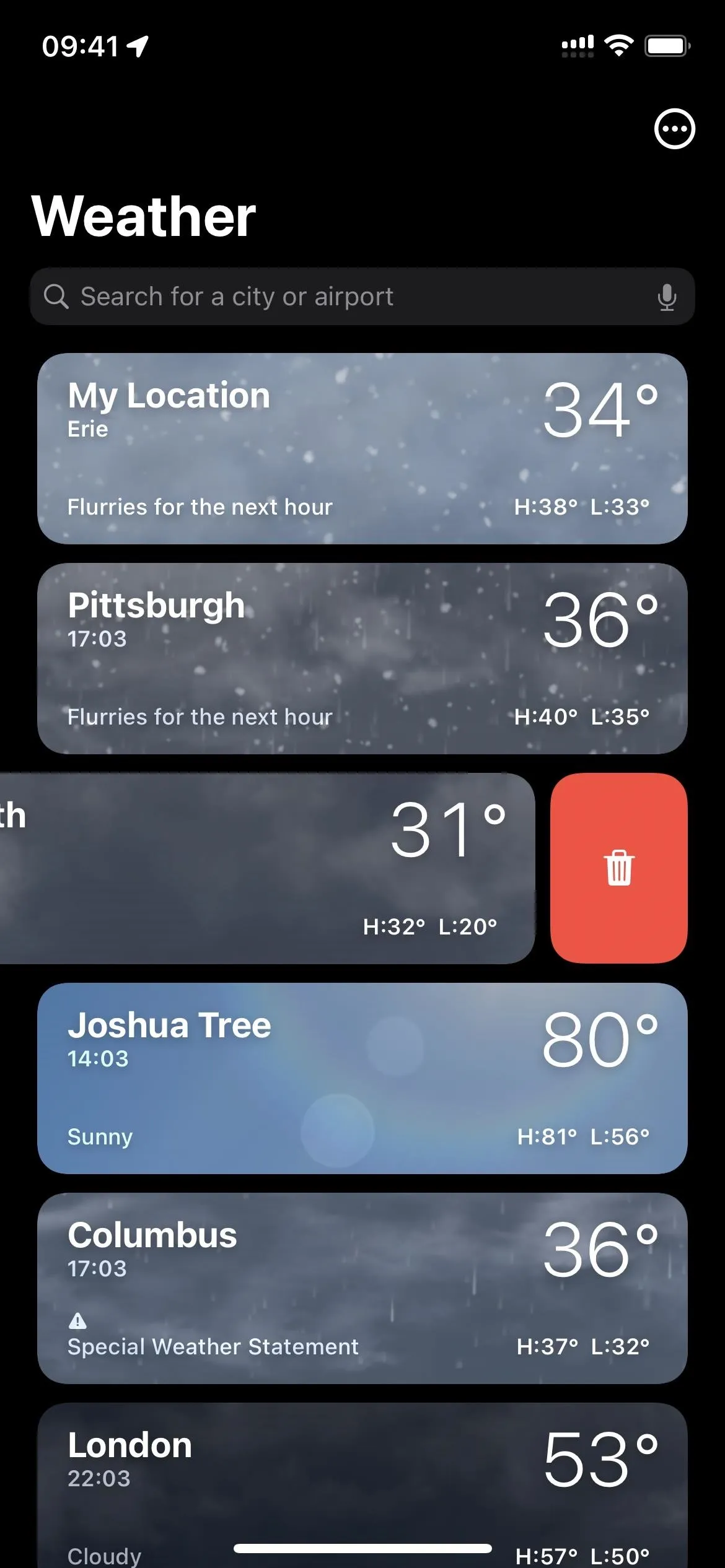
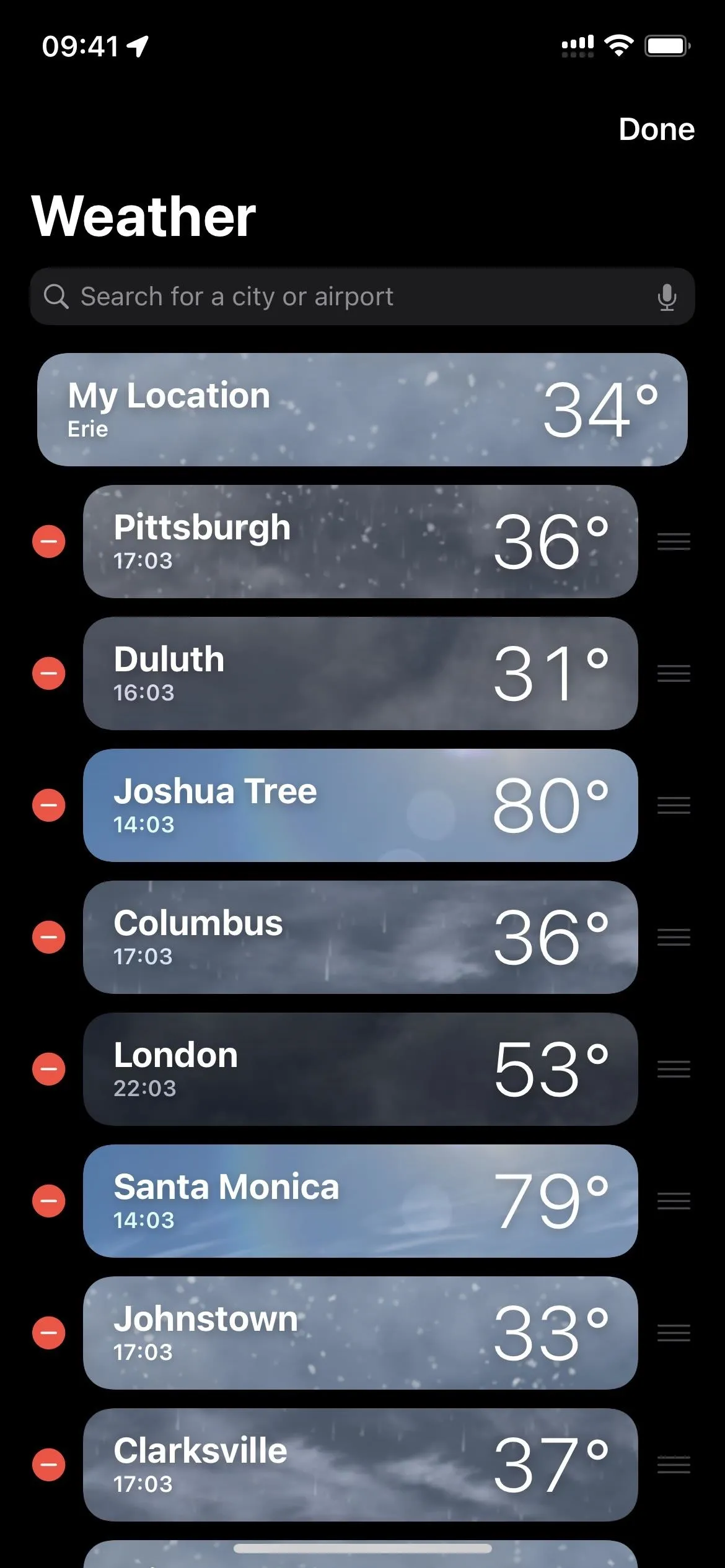


2. Reorder Your Cities
If you find yourself swiping past or scrolling down too many cities to get to the ones you need, you can change the order in which they appear. Open the list view, tap a location, then drag and drop it to a new place on the list. Note that "My Location" can't be moved.
You can also hit the ellipsis (•••) icon, tap "Edit List," then use the three-lined icon next to each city to drag and drop it to a new spot on the list.
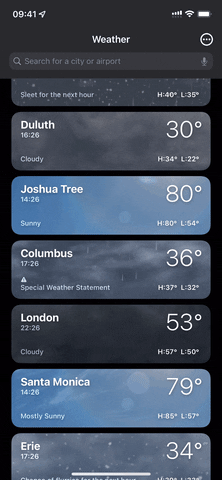
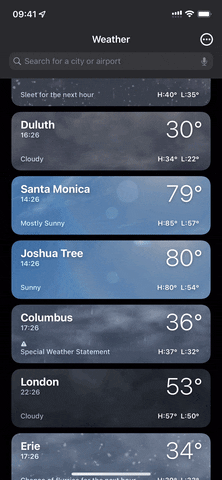


3. Choose Your Preferred Temperature Unit
Apple automatically sets your temperature unit based on where you live, so it will likely be Fahrenheit (ex. 89ºF) if you're in the U.S. However, if you want to use Celsius (ex. 32ºC), you can. From the list view, tap the ellipsis (•••), then choose your preferred temperature unit. You can also open Settings, tap "Weather," and change the unit from there.
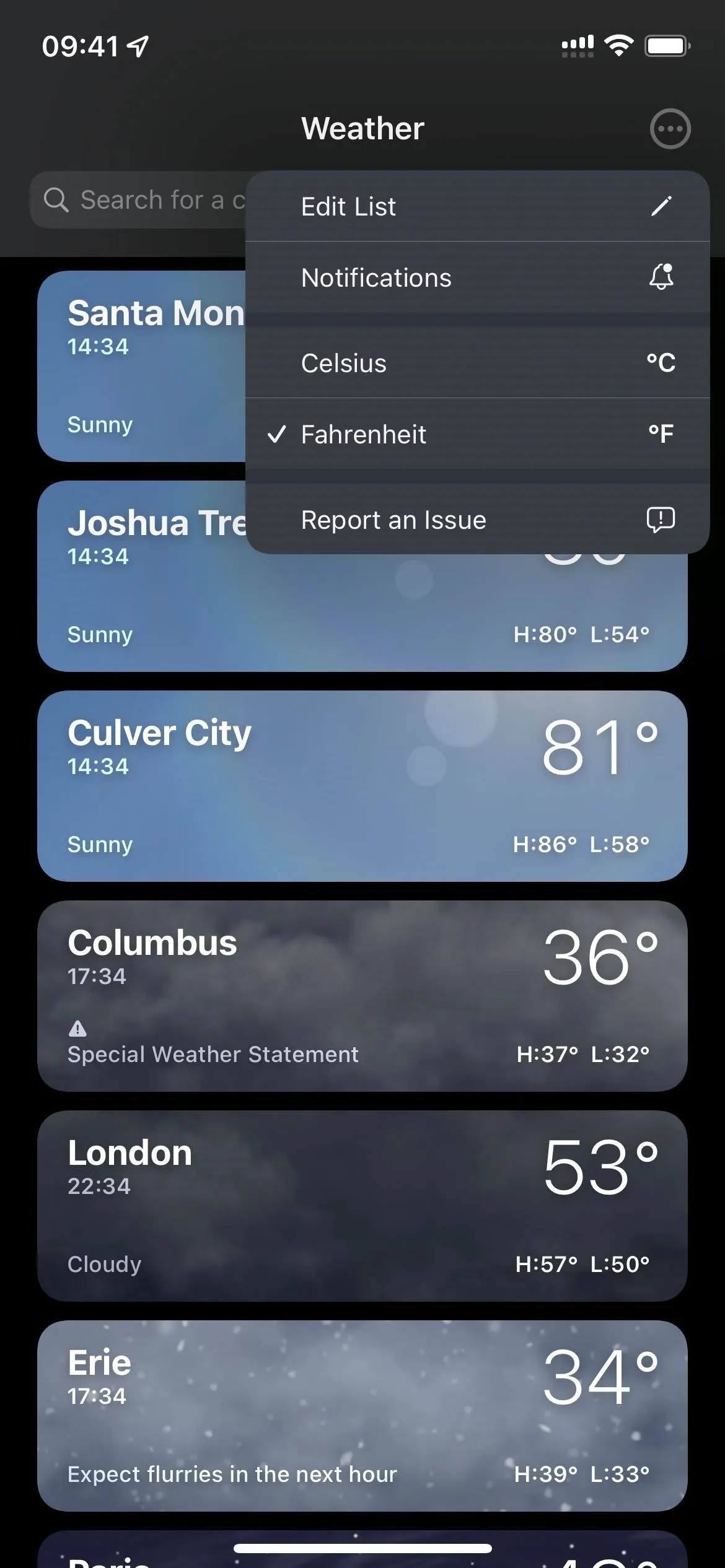



4. Change the Text Size
You could change the text size on your iPhone on previous iOS versions, but with iOS 15 and iOS 16, you can set your preferred text size for Weather individually. That way, the text size won't affect the rest of the device — only the Weather app.
To quickly change the text size, use the "Text Size" control in Control Center. If you don't see it, go to Settings –> Control Center, then add it. Make sure you're in the Weather app, open Control Center, tap the "AA" button, then choose "Weather Only." Next, adjust your size as needed. You may need to do this a few times until you find the sweet spot for Weather.
Alternatively, you can go to Settings –> Accessibility –> Per App Settings –> Weather. If you don't see it, tap "Add App" and choose "Weather" from the list. From here, you can tap "Larger Text" and adjust the text size as needed.
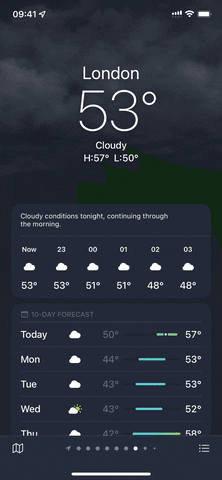
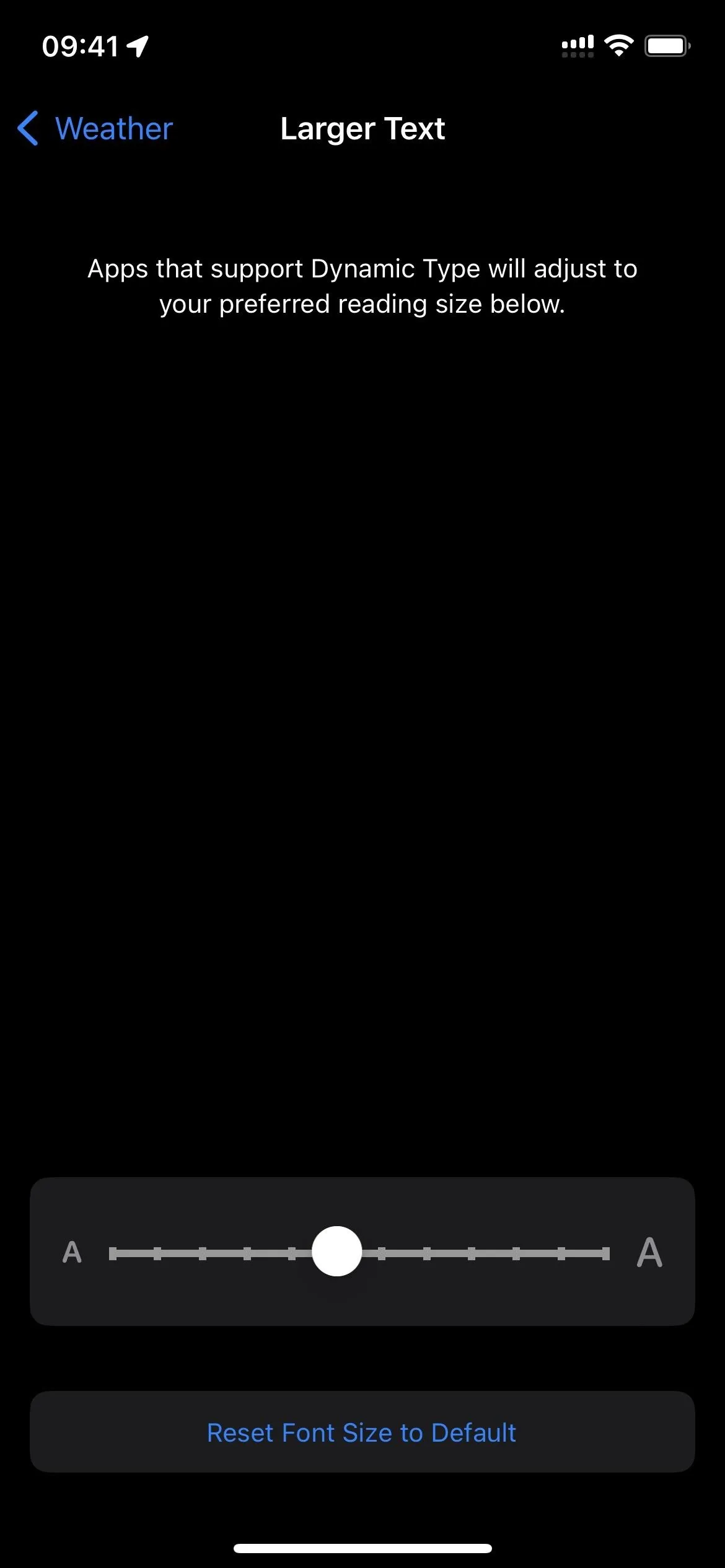


5. Choose Regular or Bold Text
In iOS 15 and iOS 16, you can also give only the Weather app bold text. To do so, go to Settings –> Accessibility –> Per App Settings –> Weather. If you don't see it, tap "Add App" and choose "Weather" from the list. From here, you can tap "Bold Text" and turn it on or off or keep it at the default setting, which uses your system-wide bold preference.
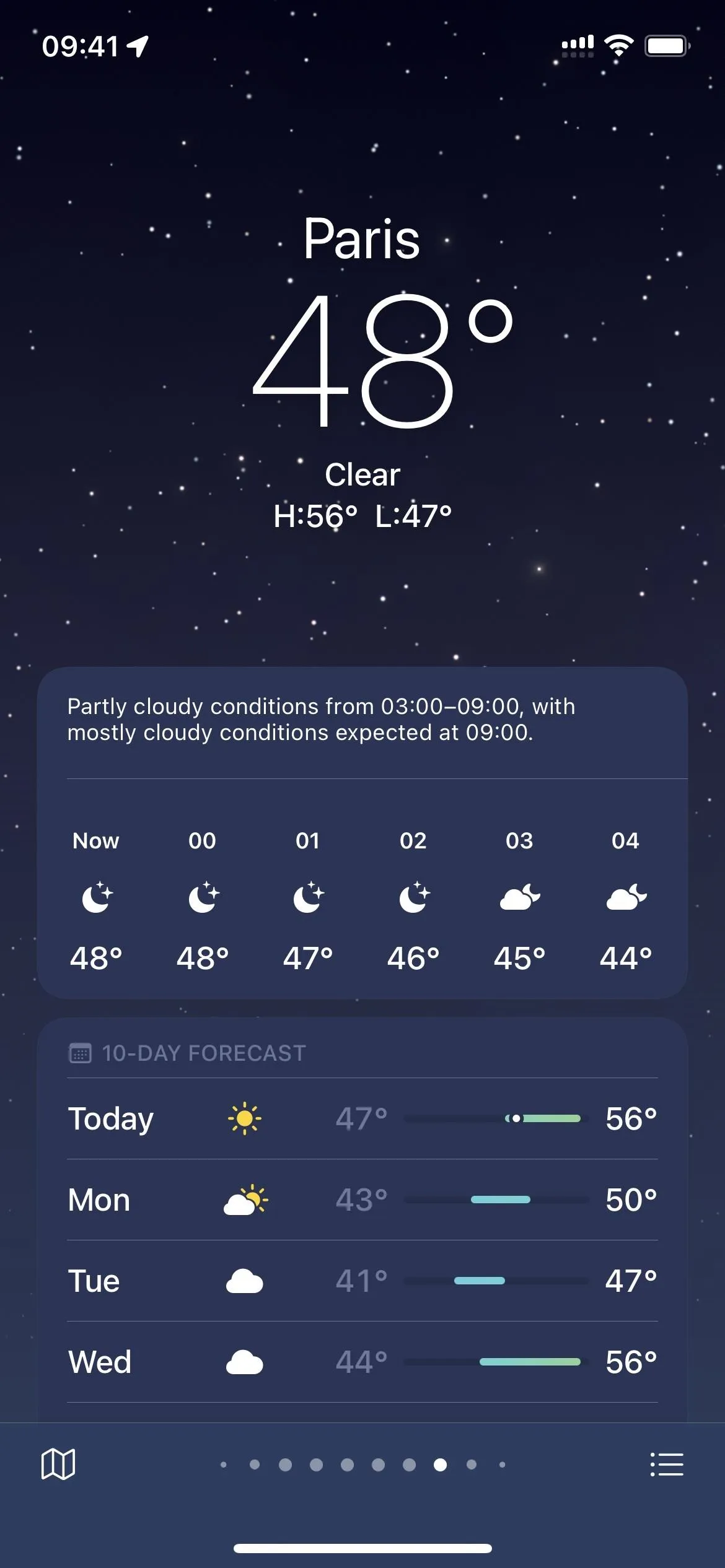



6. Use Button Shapes
You can also add button shapes to the Weather app in iOS 15 (it doesn't seem to do anything in iOS 16). Go to Settings –> Accessibility –> Per App Settings –> Weather. If you don't see it, tap "Add App" and choose "Weather" from the list. From here, tap "Button Shapes" and turn it on or off or keep it at the default setting, which uses your system-wide button shapes preference.
With it enabled, the map and list icons will have a button-shaped background. Also, you'll see a similar background for the precipitation, air quality, and temperature maps on each city, as well as the "Report an Issue," "Manage Notifications," "Open in Maps," The Weather Channel, and BreezoMeter buttons at the bottom of each city view. You'll also notice a few button shapes when messing around with your settings.
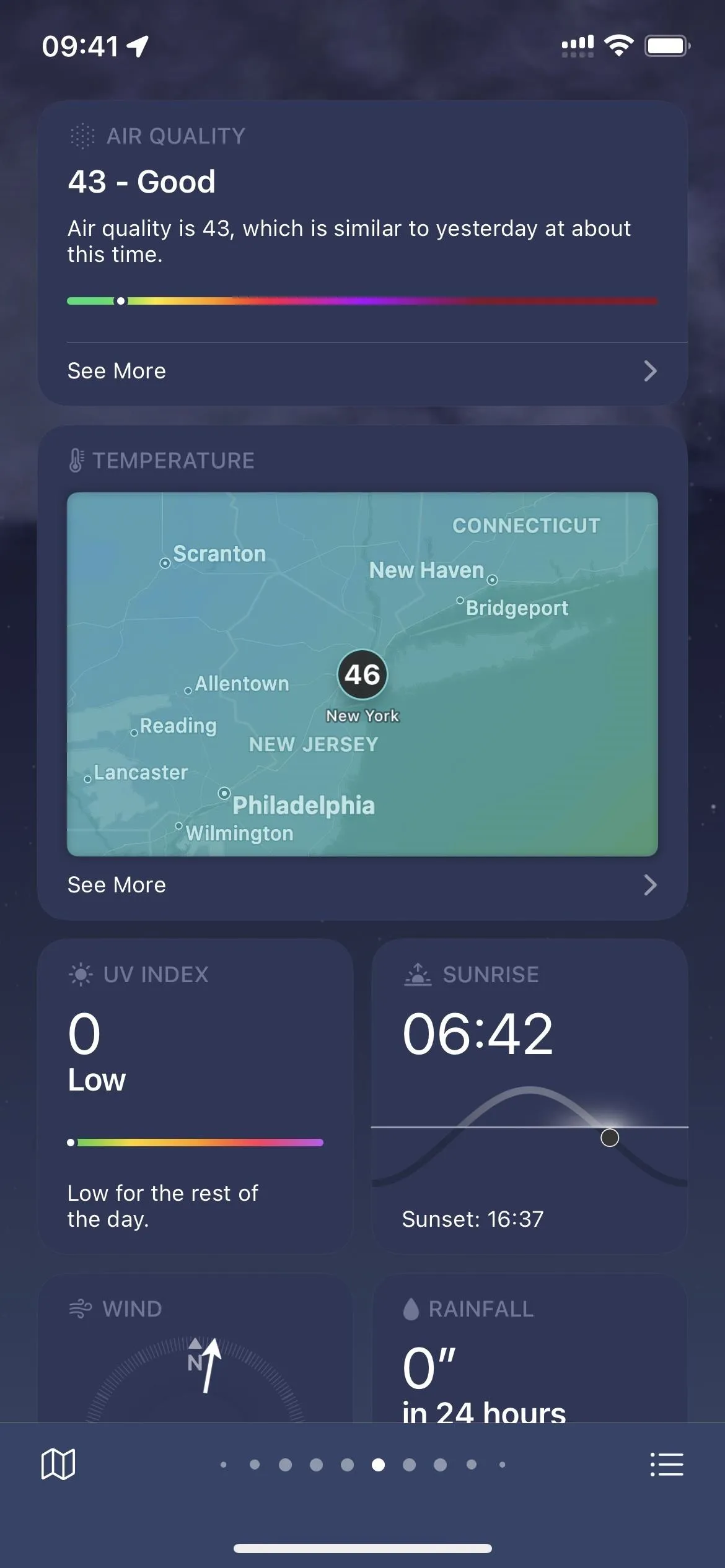
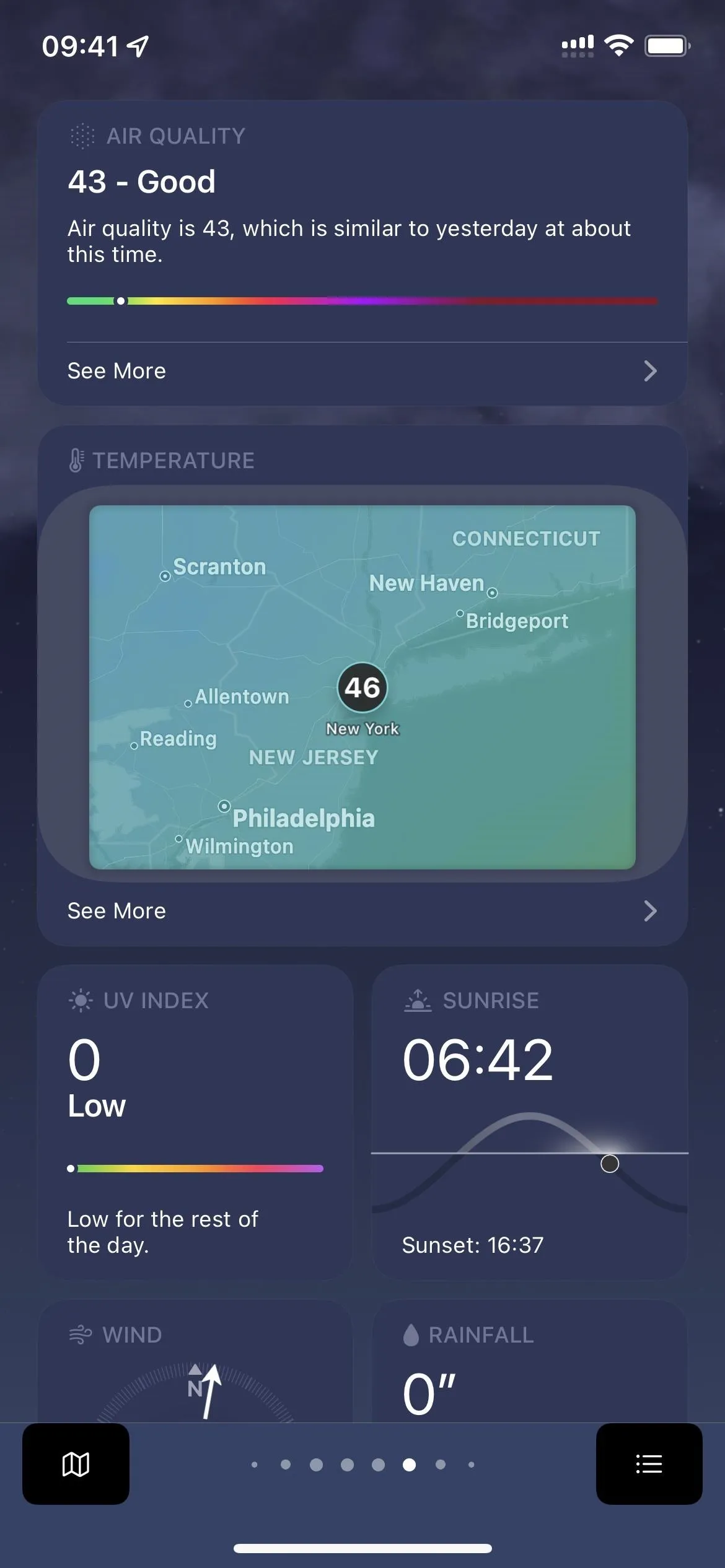


7. Activate Smart Invert
Smart Invert intelligently inverts the colors of the UI, carefully choosing what gets inverted and what doesn't. In iOS 14, you had to set up an Accessibility Shortcut, Back Tap, or Shortcuts automation if you wanted Weather to use the Smart Invert feature to change the colors of the app. That's no longer necessary since iOS 15 and 16's per-app settings also let you set Smart Invert for Weather only.
Go to Settings –> Accessibility –> Per App Settings –> Weather. If you don't see it, tap "Add App" and choose "Weather" from the list. From here, tap "Smart Invert" and turn it on or off or keep it at the default setting, which uses your system-wide Smart Invert preference.
You won't notice much difference in the list view, but the colors for charts, widgets, and maps will look inverted. The color change intensifies when Dark Mode is enabled.

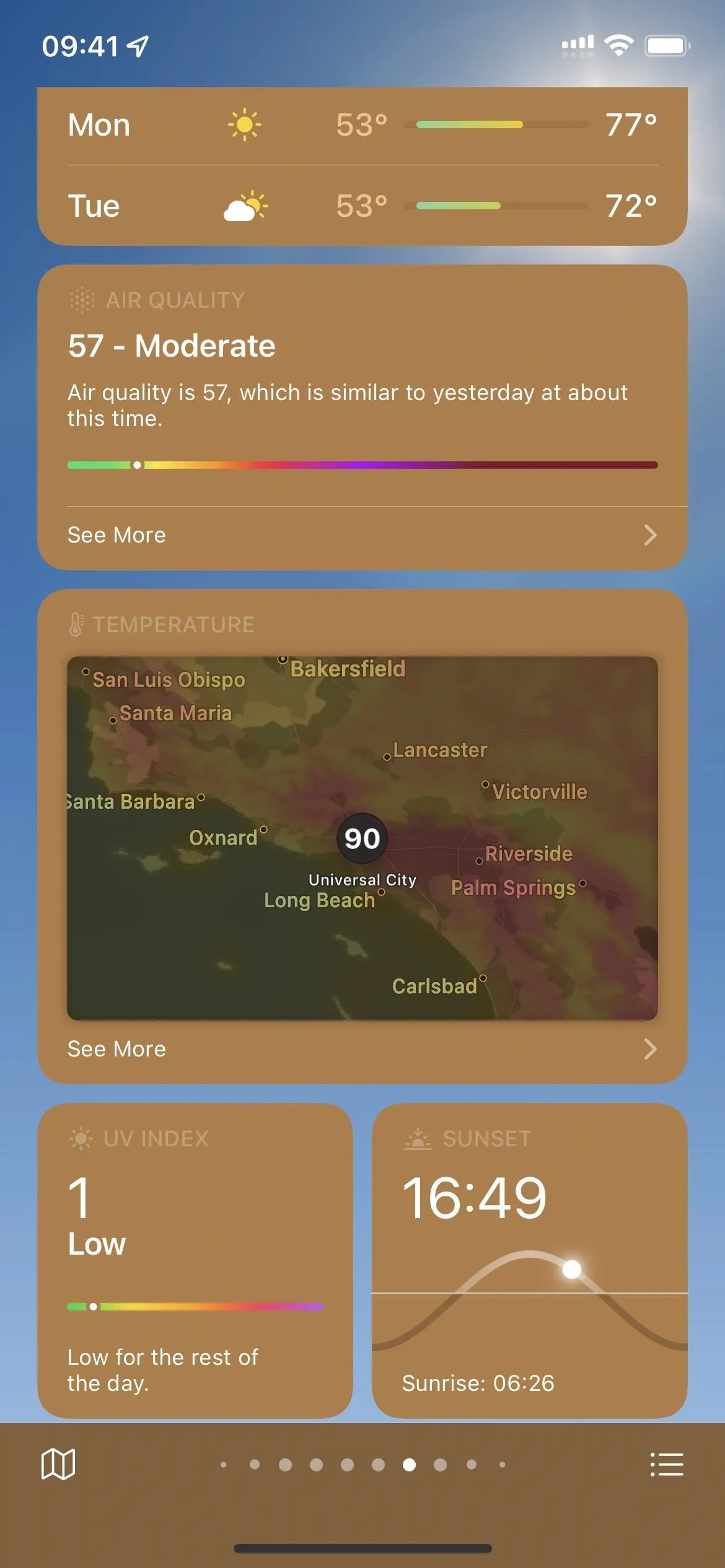


8. Reduce the Motion on the Screen
If you're not into all of the animated effects in Weather, you can turn them off without affecting anything else on your iPhone. Like some of the customizations above, this only works in iOS 15 and later.
Navigate to Settings –> Accessibility –> Per App Settings –> Weather. If you don't see it, select "Add App" and choose "Weather" from the list. Then, tap "Reduce Motion" and turn it on or off or keep it at the default setting, which uses your system-wide Reduce Motion preference.
The animations for rain, snow, clouds, thunderstorms, clear nights, and sunny skies, to name a few, should now be static in each city's detailed view. Animations will also stop moving in the list view. However, it should not affect maps.
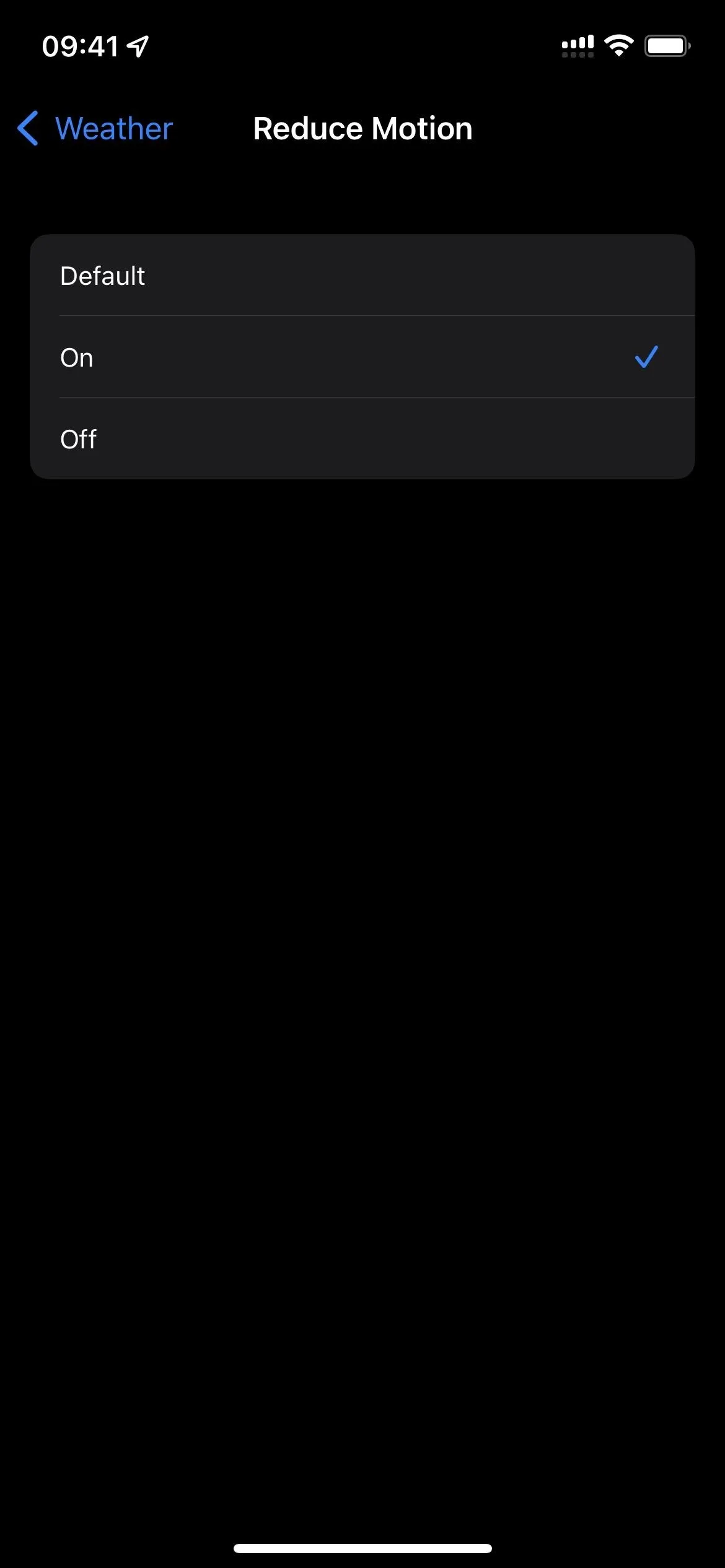
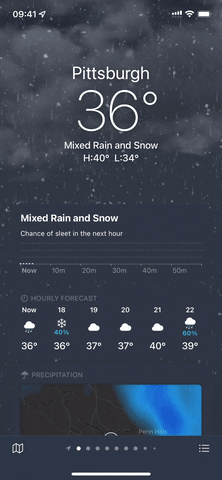


9. Increase the Screen's Contrast
Another option in the "Per App Settings" for Weather in iOS 15 and iOS 16 is "Increase Contrast." With it enabled, there is a subtle change for menus and text in Weather that makes things easier to see and read. If you notice the difference easily, you might want to use it.
Again, go to Settings –> Accessibility –> Per App Settings –> Weather. Select "Add App" and choose "Weather" from the list if you don't see it. Then, tap "Increase Contrast" and turn it on or off or keep it at the default setting that uses your system-wide Increase Contrast preference.
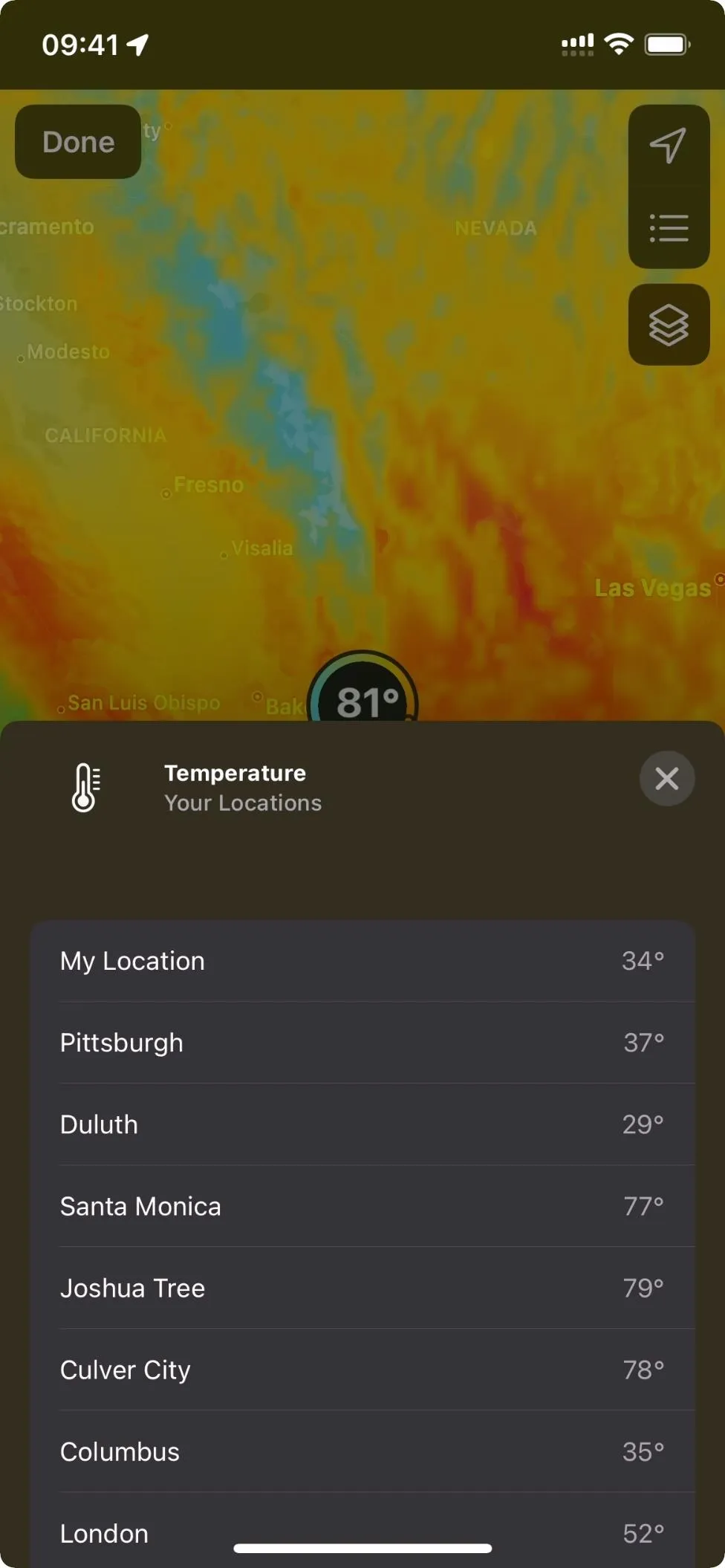
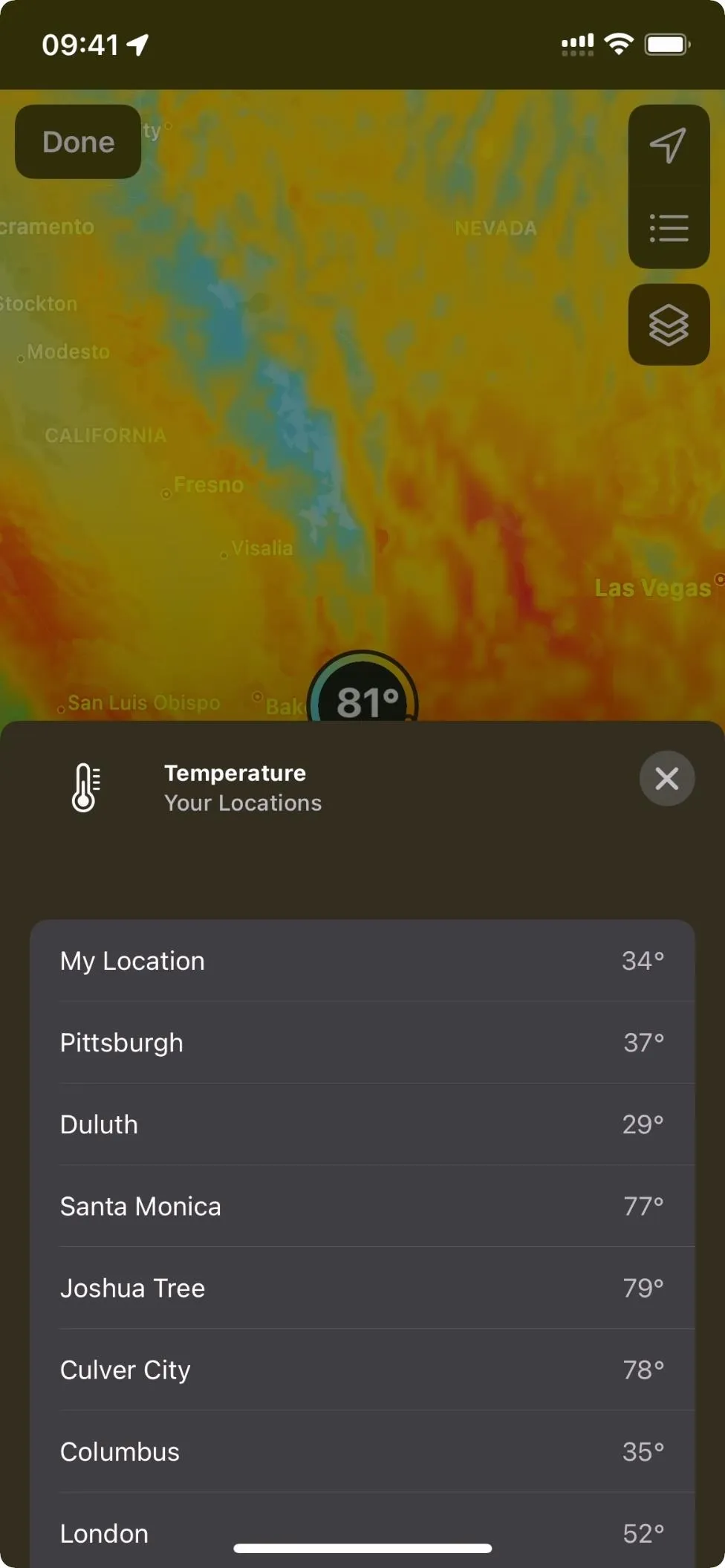


10. Reduce the Transparency
Another subtle change you can make to Weather "reduces the transparency and blurs on some backgrounds," as Apple would say. It's most apparent in daylight city views. Just like some of the previous features, this is for iOS 15 and later only.
Visit Settings –> Accessibility –> Per App Settings –> Weather. Use "Add App" to find and add "Weather" if you don't see it. Next, tap "Reduce Transparency" and turn it on or off or keep it at the default setting that uses your system-wide Reduce Transparency preference.




11. Enable Classic Invert
Apple included quite a bit customization options for its "Per-App Settings" in iOS 15 and iOS 16, but it missed some of the best ones. While "Smart Invert" is there, "Classic Invert" is nowhere to be seen. The smarter one intelligently inverts only what it thinks is needed, but the classic version inverts most everything. In Weather, it can be an interesting way to view city forecasts.
Since there's not a specific setting in Weather for it, you'll have to rely on enabling "Classic Invert" manually, by using the Accessibility Shortcut, or by tapping the back of your iPhone two or three times. Even better, you can set up an automation that turns on "Classic Invert" when you open Weather, then disables it when you exit.
- Full Instructions: How to Change the Color Theme of Any App Interface on Your iPhone — Without Affecting the Rest of iOS
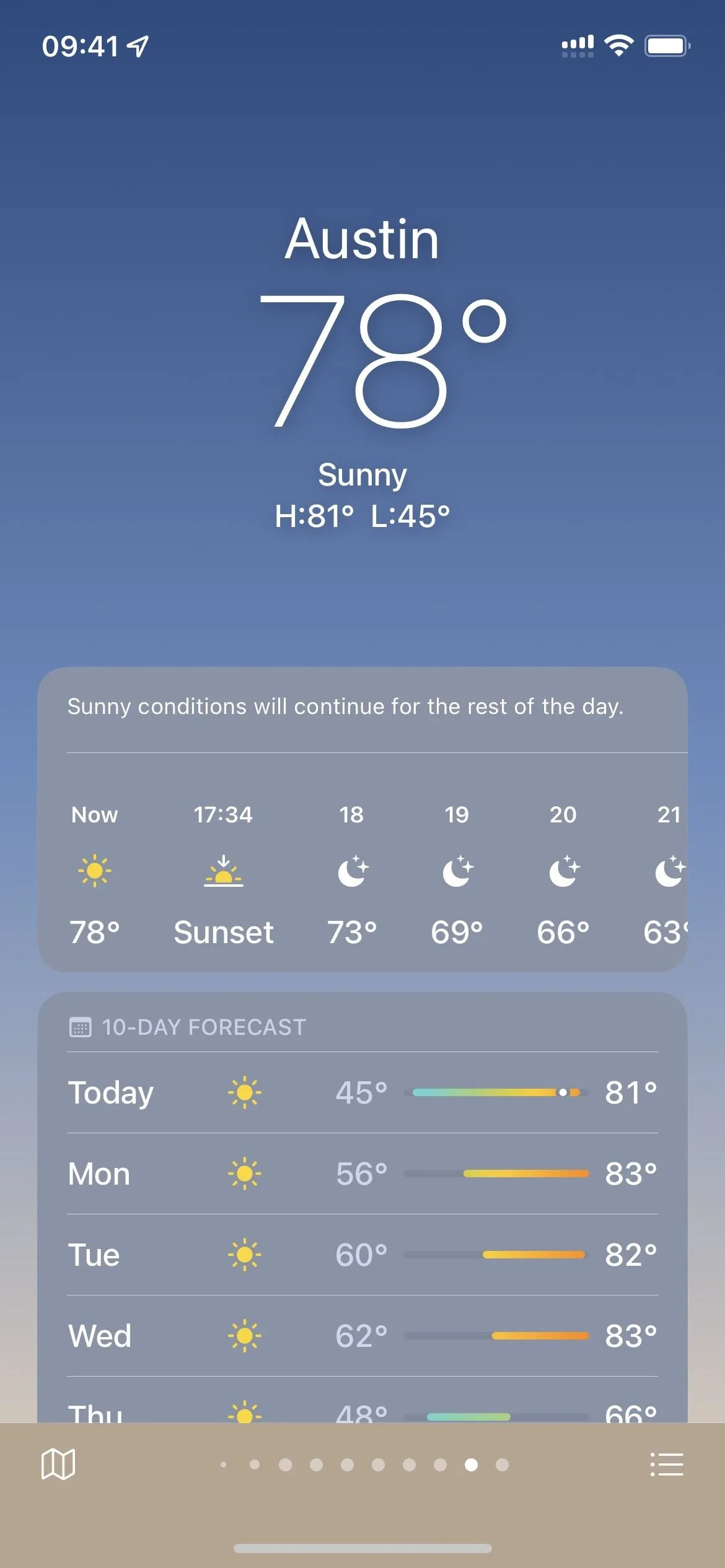
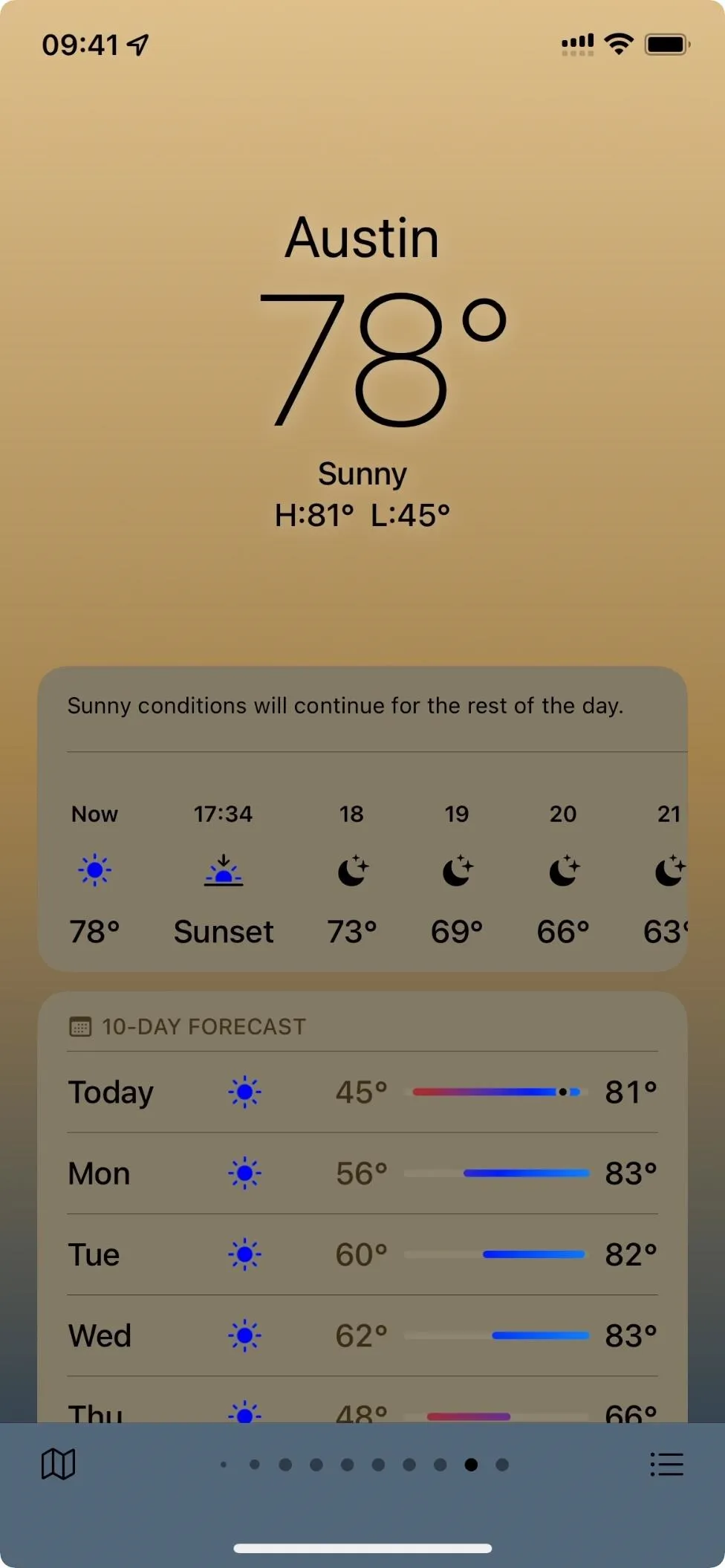


12. Reduce the White Point
As with "Classic Invert," you can set up an automation, Accessibility Shortcut, or Back Tap with the "Reduce White Point" feature in iOS. By reducing the white point in the Weather app, you're decreasing the brightness of the whites on the screen, and you can make the screen look darker overall with the slider control.
- Full Instructions: How to Change the Color Theme of Any App Interface on Your iPhone — Without Affecting the Rest of iOS
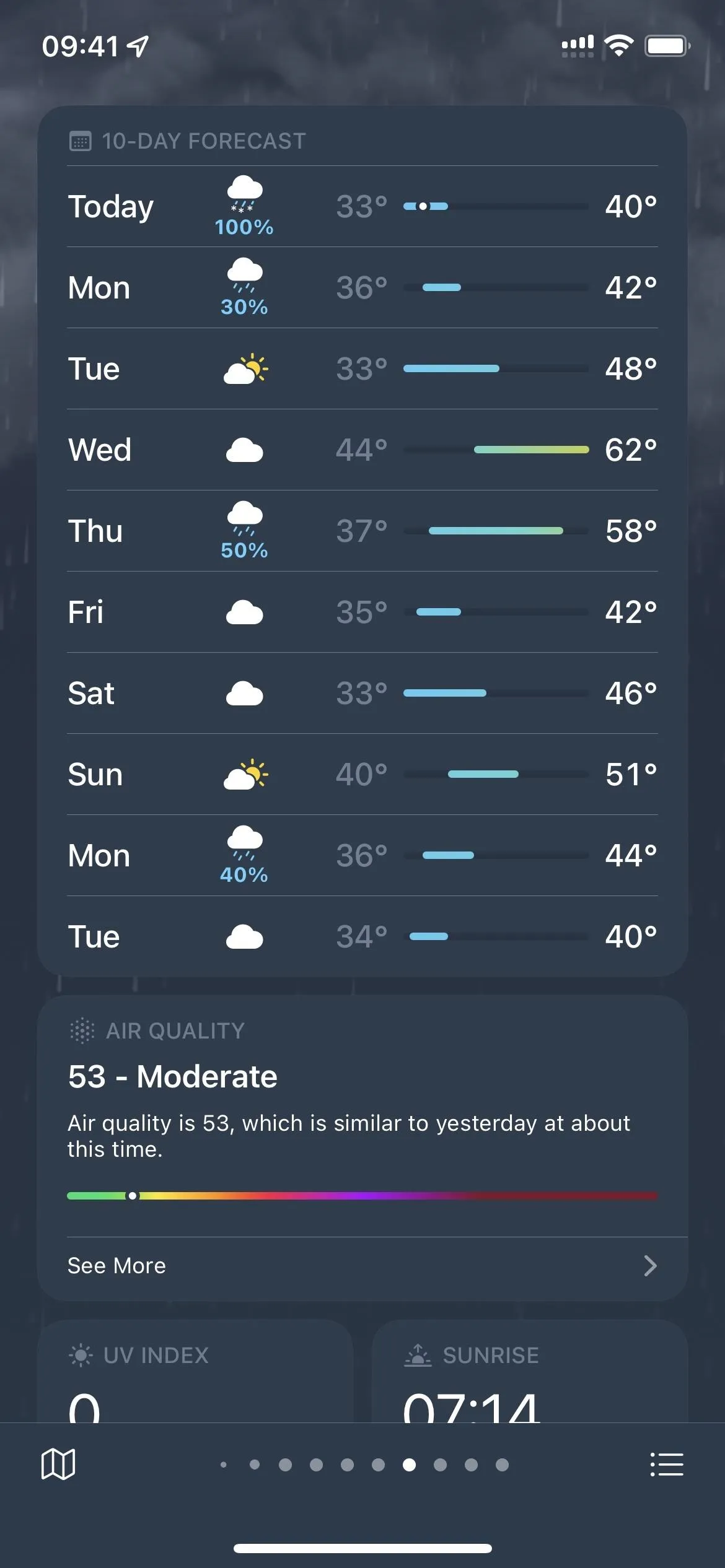



13. Use Zoom to Lower the Brightness
If the "Reduce White Point" setting doesn't get Weather's brightness down enough for you, you can try out "Zoom" in conjunction with it or instead of it. With "Zoom," you can make Weather's UI brightness lower than what iOS would typically let you get to with the regular brightness controls. You can also set up an automation for this, an Accessibility Shortcut, or a Back Tap.
- Full Instructions: How to Change the Color Theme of Any App Interface on Your iPhone — Without Affecting the Rest of iOS
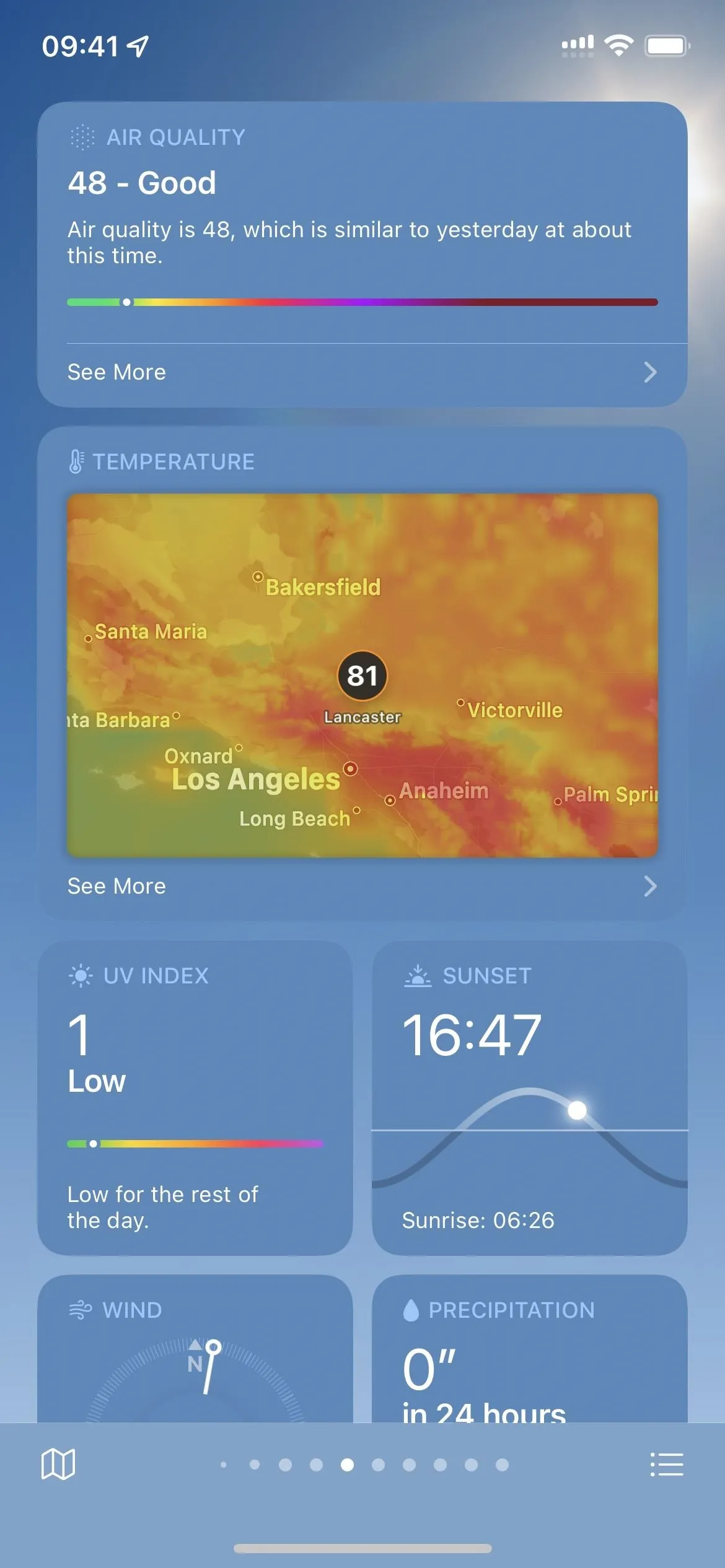
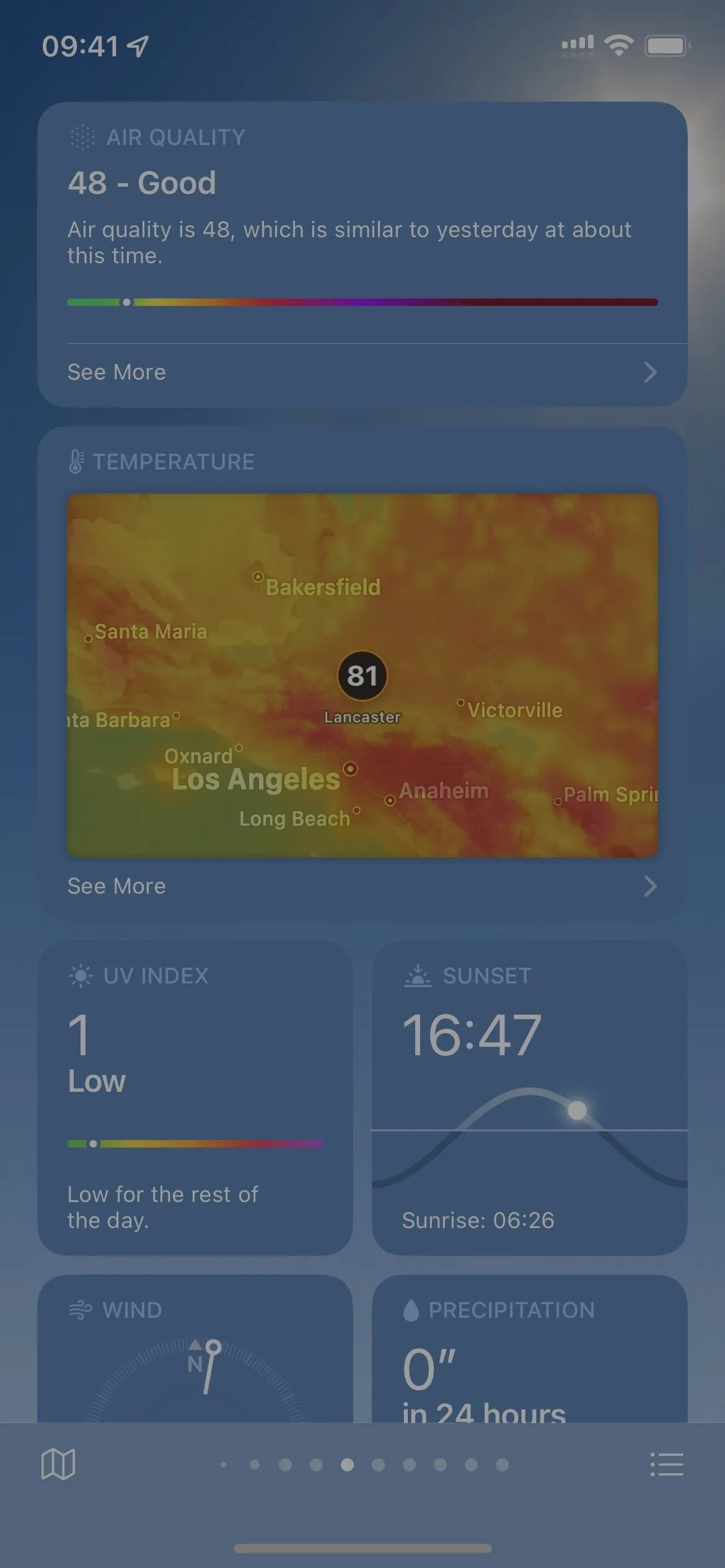


14. Assign It Dark or Light Mode
Another option you can automate with Shortcuts or assign to an Accessibility Shortcut or Back Tap is "Dark Mode" and "Light Mode." For Weather, you'll mostly notice the difference in menus, but some map views will also adapt to the dark or light change.
- Full Instructions: How to Change the Color Theme of Any App Interface on Your iPhone — Without Affecting the Rest of iOS
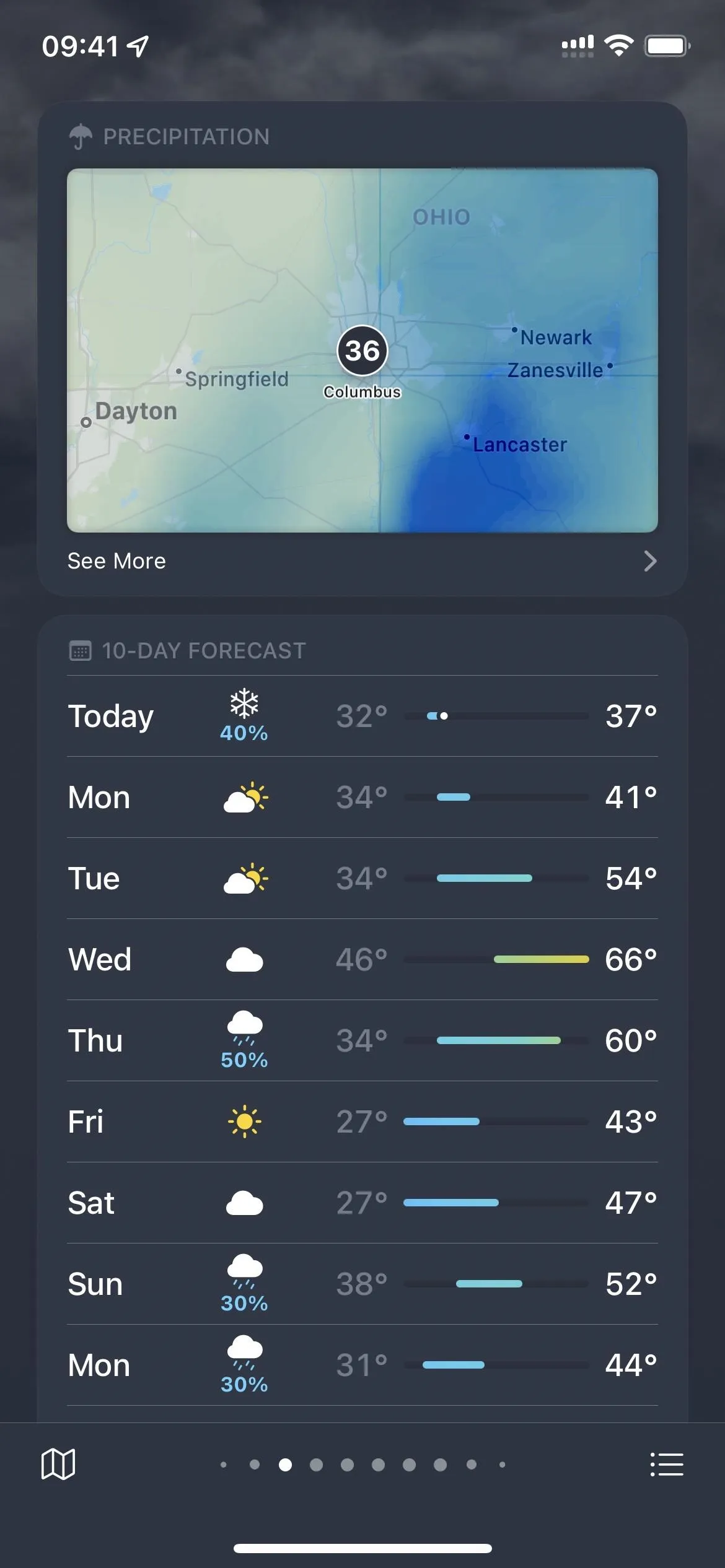



15. Apply Color Filters
Apple has an accessibility setting for iPhone that overlays color filters on the screen. It's helpful to people with color vision deficiency, is an excellent tool for amateur astronomers, and is useful when you're in bed trying to go to sleep. It's also fantastic for just colorizing the Weather app's interface.
If you're running iOS 16, you can set an automation to run the "Set Color Filters" action and automatically apply a color filter whenever you open Weather and remove it when you close Weather.
However, you cannot set the same automation in iOS 15. Instead, you can use the Accessibility Shortcut or Back Tap to enable/disable your filter. However, you can use "Zoom" above to apply filters such as Grayscale, Grayscale Inverted, and Low Light, which is the next best thing.
You could make Weather grayscale or use a color tint of your choosing. There are also specific filters to help with protanopia, deuteranopia, and tritanopia.
- Full Instructions: How to Change the Color Theme of Any App Interface on Your iPhone — Without Affecting the Rest of iOS
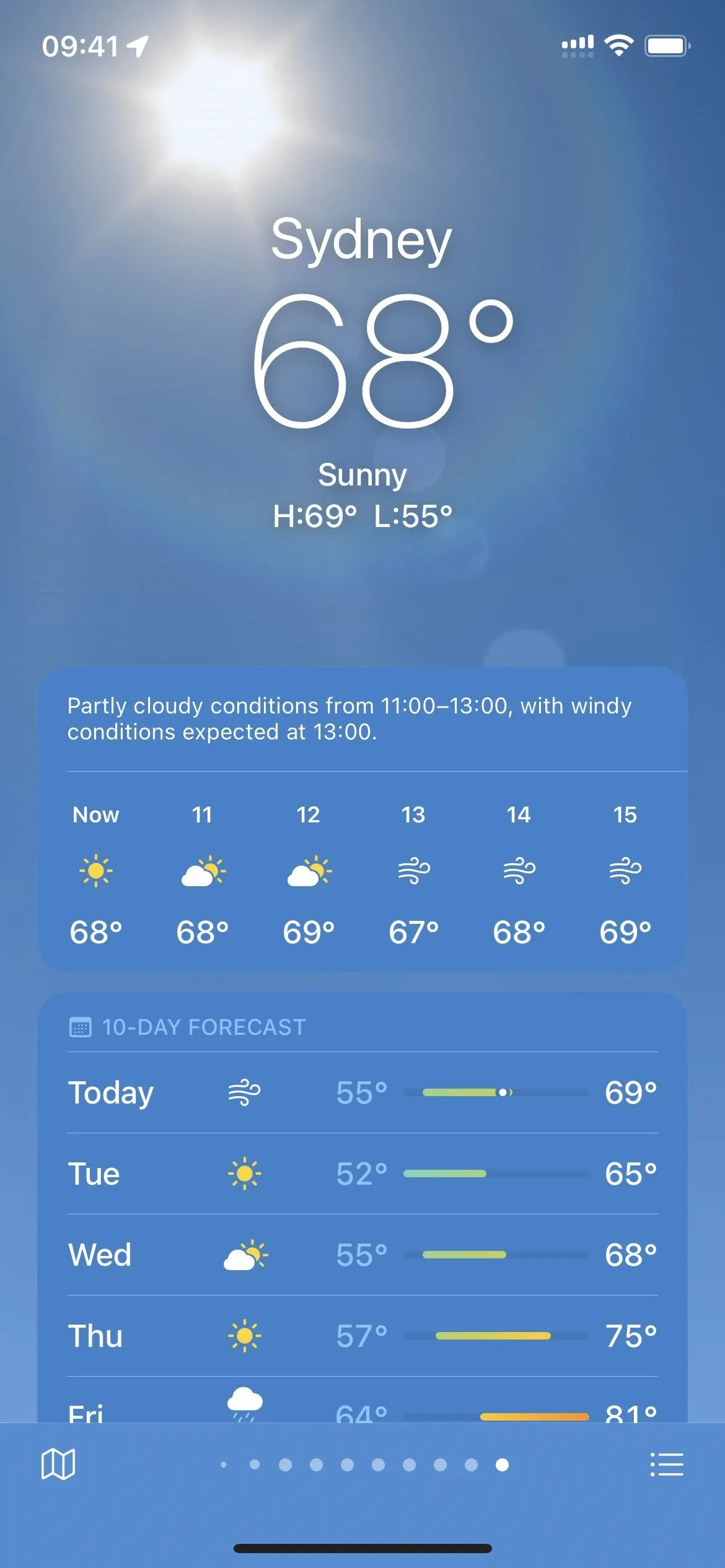
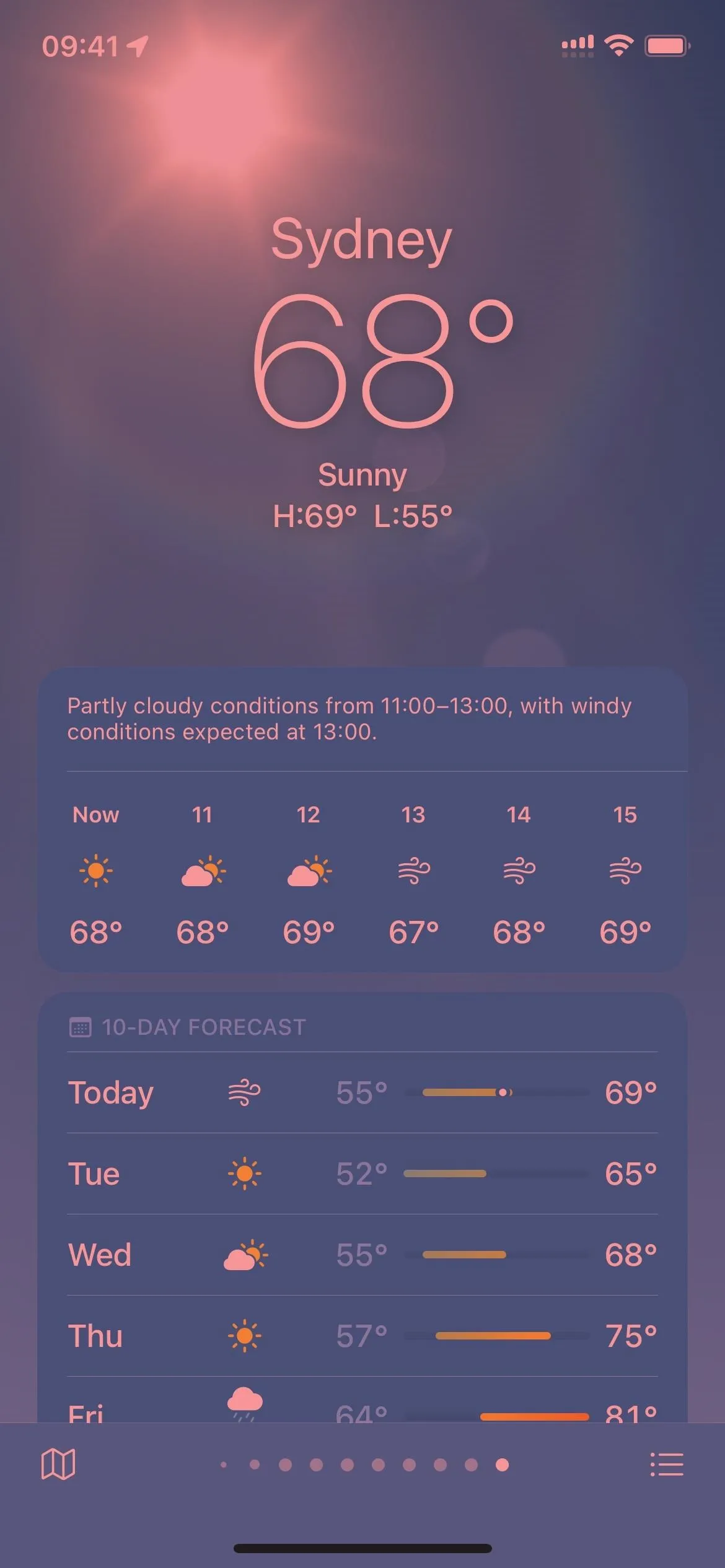
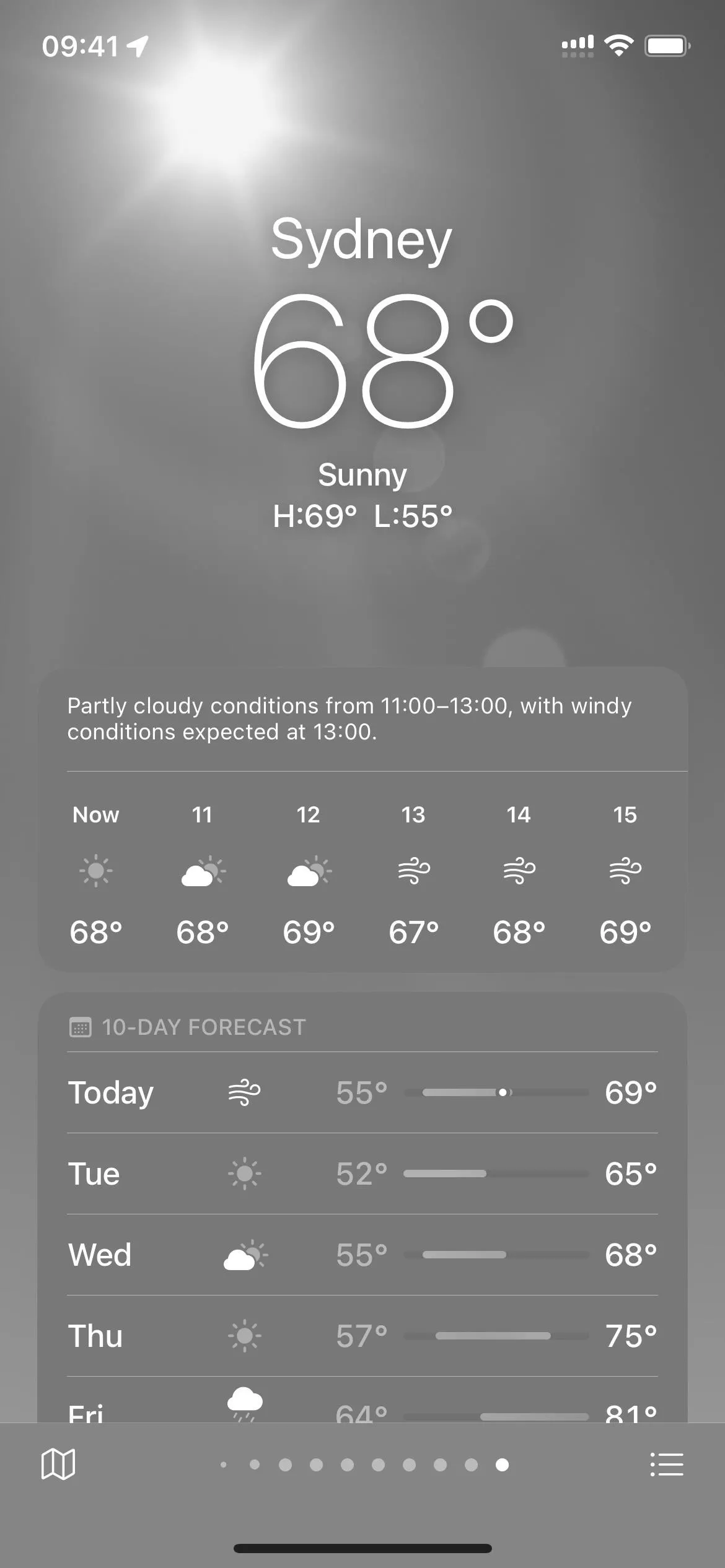



16. Choose a Background Sound
Apple added an exciting feature in iOS 15 and later that lets you turn your iPhone into a personal sound machine. There are six tracks to use as background noise, which can help with stress, sleep, and distractions.
"Background Sounds" can also set the mood for whatever app you're using. In Shortcuts, Apple's automation tool, you can actually assign background sounds to individual apps so that they automatically start playing when you open a linked app. You can even make the sound stop when you exit the app.
- Full Instructions: These Hacks Make Your iPhone Apps Play Different Background Sounds When You Open Them

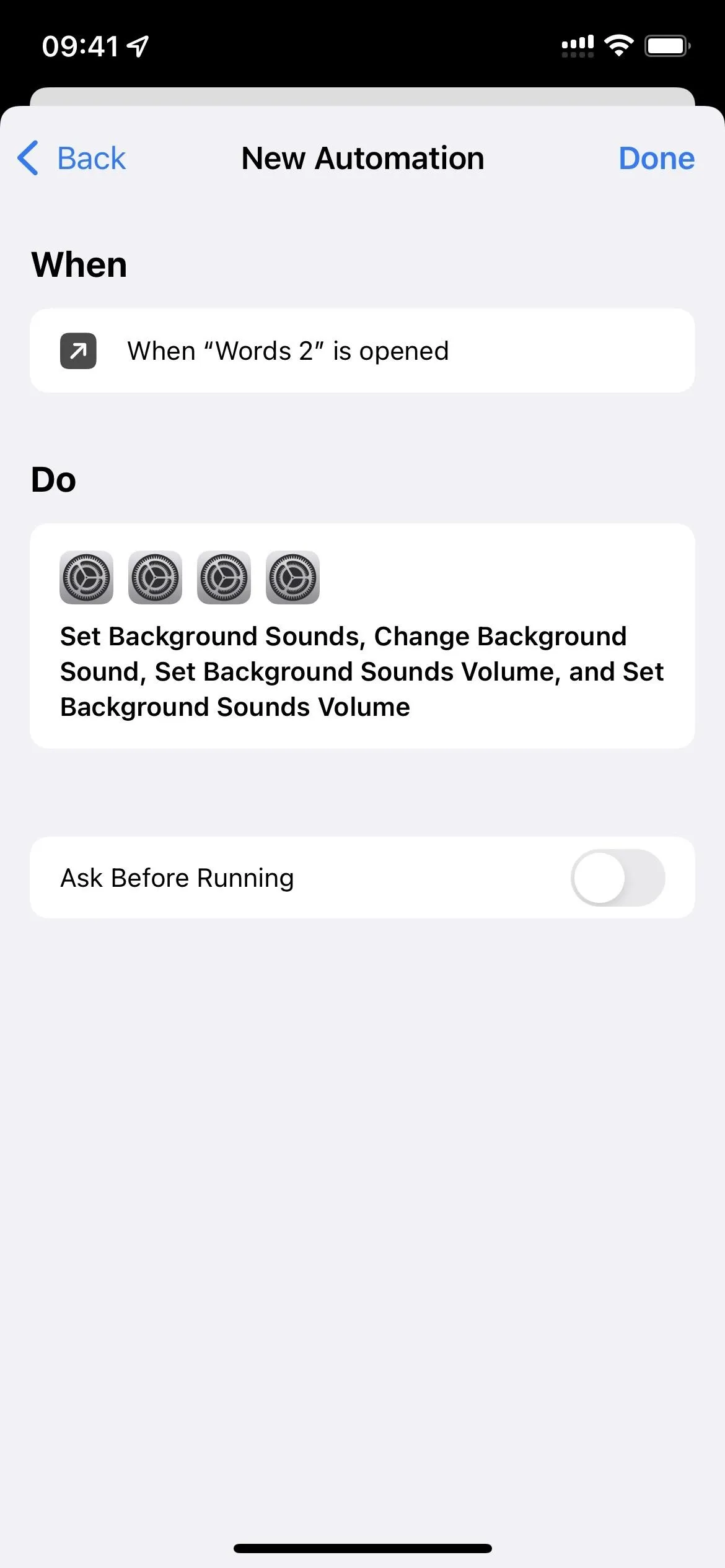


17. Set Alerts Per Location
In iOS 16, you can enable or disable alerts for severe weather and next-hour precipitation for every city you've added to Weather. Not every city has both options, and in iOS 15, you can only toggle on or off all alerts for each location.
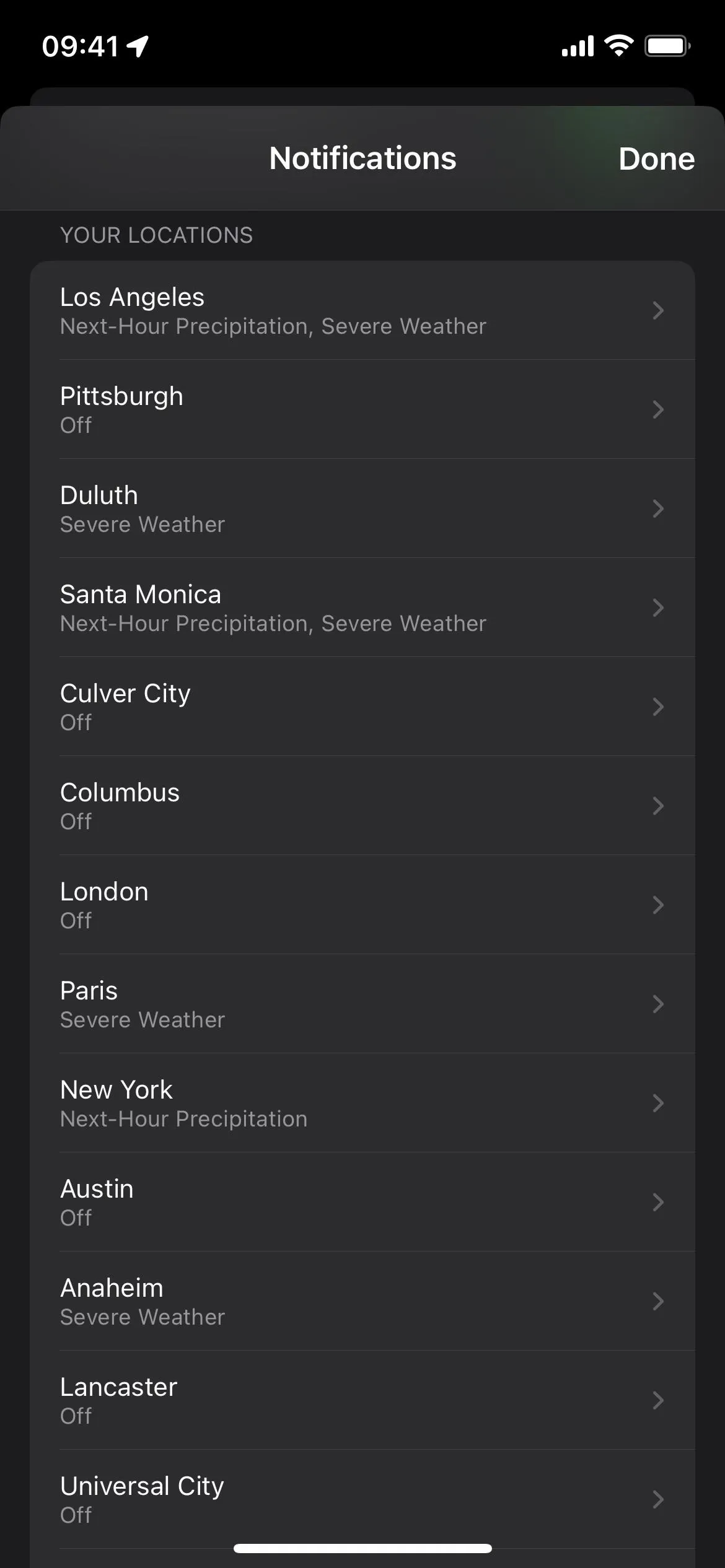
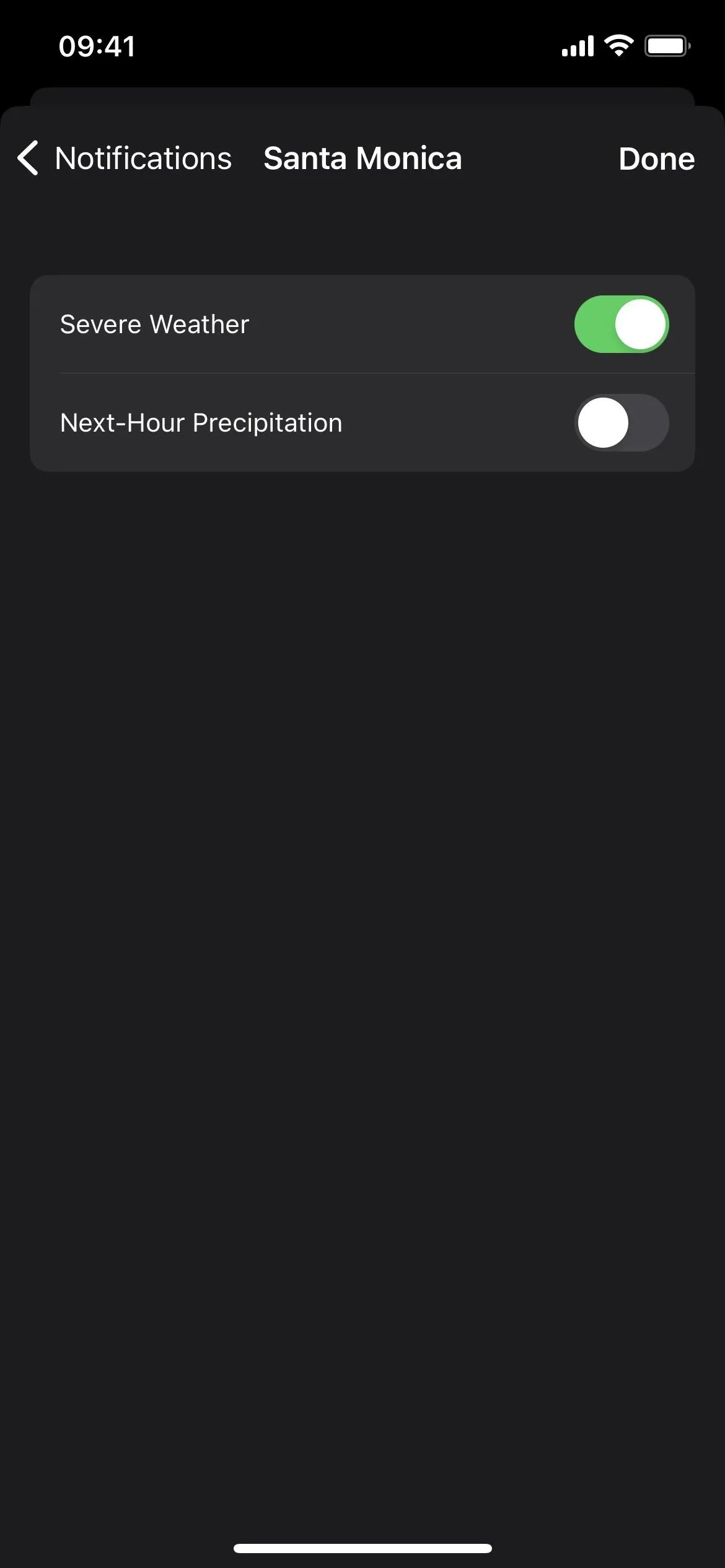




Find Out More About iOS 16 Weather Updates
When you update to iOS 16, you'll get a ton of new features in the Weather app, including a live wallpaper and Weather widgets for your lock screen, severe weather alerts, more hourly and 10-day forecasts, and more. Make sure to check out all the new options in our iOS 16 Weather app roundup. I didn't include many of them in the customization options above because things like widgets and wallpapers are for outside the app, and there are new features you can't customize.
Cover photo, screenshots, and GIFs by Justin Meyers/Gadget Hacks






















Comments
Be the first, drop a comment!